The summer of 1982 was about as exciting as it could get for sci-fi fans. Just take a look at the cover of STARLOG #62 from that September – Star Trek II! Revenge of the Jedi in pre-production! The year would see Blade Runner, E.T., and many others, including TRON. While TRON: Legacy, which arrives in theaters this week 28 years after the original film, is just another blockbuster film taking place in a virtual world, back in 1982 no one really knew what to expect from computer-generated effects. Aside from the brief Genesis Planet sequence in Star Trek: The Wrath of Khan (created by plucky new division of Lucasfilm that would eventually evolve into Pixar), cinemagoers hadn’t really experienced computer animation, and certainly nothing on the scale of TRON.
The scope of the effects work in TRON remains impressive today; many of the film’s effects weren’t computer generated, and were created with traditional tricks and techniques. The film’s otherworldly look came from this elaborate and very labor-intensive process, and laid the groundwork for much that came after.
This interesting article appeared in STARLOG and gives a hint of what roadblocks the filmmakers encountered during production. There are also some predictions of what this all means for filmmaking, many of which are quite prescient and all of which are entertaining.
By DAVID HUTCHISON
Take a moment to read the credits at the end of Disney’s TRON. TRON is the first feature film to employ computer graphics on a large scale. And with the new machines come new jobs and job titles for moviemakers. One of the more interesting sounding credits to be found at the end of TRON is “Computer Image Choreographer.” The two names listed are Bill Kroyer and Jerry Rees.
Back in May, before TRON was completed, STARLOG found Bill Kroyer behind a Chromatics computer monitor at the Disney studios. Kroyer joined the Disney studios with Pete’s Dragon and even animated a bit of Fox and the Hound. So what’s an animator doing sitting behind a computer terminal?
“I’m looking at a ‘pencil test’ for a sequence from TRON that is being sent over the phone lines from the computers at MAGI in Elmsford, N.Y.,” came the easy reply. “It’s my job or part of my job as computer image choreographer [C.I.C.].”
“Oh. And what is …. “
“… a computer image choreographer?” smiles Kroyer. “Well, it’s certainly the first time that credit will appear on the motion picture screen, because this is the first time this process has ever appeared on the screen on this scale.
“Computer generated imagery, what we call ‘scene simulation’ and which most people tend to call ‘computer animation,’ is really an up-and-coming fast-moving field. The basic idea is to generate pictures on the screen that are not drawn or painted by anyone, or built as models first. They are scenes that are completely constructed in the imaginary mind of the computer. Then the computer reads out that imagery on a piece of film, which is processed printed and projected as ordinary movie film.
“What Jerry and I do as computer image choreographers is to describe the imagery to the computer. We describe all of the geography and all of the hardware. Basically we use blueprints and maps that describe the ‘physical reality’ of a scene to the computer. Then we describe the action or choreography of those objects and the computer puts it all together into a scene. You might say it ‘visualizes’ it. Then the computer ‘reads-out’ that information onto movie film. Basically, we are creating a computer image and then we are choreographing the action of the image. Hence, the name – computer image choreographers.”
The TRON filmmakers are very excited by this new computer tool, since the images that are created are not tied down by the laws of reality. “The scenes we can visualize in our heads make it to the screen almost completely intact. There are very few limitations. At the moment the limitations are mostly technical according to the current state of the art and the amount of time and money that it takes to compute the complexity of the imagery desired. But once you adapt to working within your budget, you are pretty free to ask for just about any image you want and just about any kind of choreography you want. You can move the camera anywhere you want, there is no limitation; you can blow things up; you can move things at any speed; make 90-degree turns; you can have things completely disobey the laws of gravity or … anything. It’s a great feeling of power,” says Kroyer with obvious relish.
But the computers will not turn just anyone into an artist of the future: first the image must be in your own head. “You absolutely have to be able to visualize exactly what you want,” Kroyer warns. “You are not dealing with any sort of hard artwork, or models or actors that you can look at and manipulate … you are not dealing with anything. You have to describe to the computer exactly what you want to see. The computer will only give you what you describe and not one single bit more. If you describe it wrong, you get it wrong. The better you can visualize what you want, the more completely you can create it.”
The bulk of the picture’s computer graphics are being generated by MAGI (Mathematical Applications Group, Inc.) of Elmsford, NY and Information International Inc. (also known as Triple-I or just III) of Culver City, CA. Digital Effects of New York is also supplying computerized effects for the film.
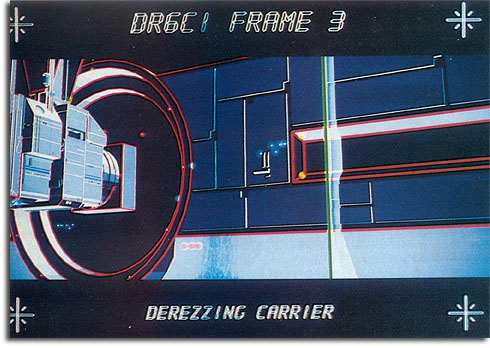 “Two samples of computer graphics from Triple-I, one of several companies supplying computer graphics for TRON. Sark’s carrier is being slowly de-rezzed as it approaches the MCP. Triple-I specializes in complex ‘organic shapes’ or objects which require complicated coloring.”
“Two samples of computer graphics from Triple-I, one of several companies supplying computer graphics for TRON. Sark’s carrier is being slowly de-rezzed as it approaches the MCP. Triple-I specializes in complex ‘organic shapes’ or objects which require complicated coloring.”Talking to Computers
Each company has their own custom hardware and software systems that create imagery. Magi’s system is called Synthavision and Triple-I uses a system called ASAS (Actor/Scriptor Animation System). It’s not necessary for the computer image choreographer to be “conversant” with the different software systems nor is it practical, so the C.I.C. relays his instructions to the programmers at each of the respective companies. The programmers then translate the
C.I.C.’s requests into the language used by each computer system.Kroyer explains how the system works by demonstrating with the scene with which he is currently working.
“The scene coming from the MAGI computers at the moment is from the Clu sequence at the beginning of the film. Clu blows up a Recognizer and the pieces smash into his tank, the tank veers out of control and smashes into a wall. One of the shots, for example, shows the exterior of the tank being hit by debris from the Recognizer and being knocked off center. To plan a scene like this, we first describe to the programmer the scene length, we give him diagrams and blueprints of the canyon where the scene takes place and then we draw diagrams of the path of action for the tank and notate the speed of the tank. The programmer already has a complete data base of the tank itself from the blueprints of the tank and they are already in the computer. Then we have to describe the angle and tilt of the tank in each frame of the shot; we have to describe when the debris hits and how the debris is falling, whether it is rotating or spinning and, well, basically we have to describe every last little thing that’s in the scene. The programmer will have to know and understand all of this so he can describe it in a numerical way to the computer.
“So, now he has a data base for the canyon, he has one for the tank, he describes the increments that the tank moves per frame, the degrees that it tilts and the degrees that it turns. He has to have a file for each piece of debris that falls and when the debris hits the tank there has to be a certain type of flare … and that has to be described.
“It’s like painting with numbers. Everything has a number – even all the colors have numbers, all the glow factors are described by numbers. You can see that by typing in numbers, eventually anything in the scene, the color, the light, the direction of the light, the direction and movement of the camera, the type of lens, etc. can be accurately specified. All of these things are given number codes; the computer understands these number codes and creates the scene. At MAGI all of this information for a given is stored on a magnetic disk. Using the disk the operator is able to change or modify any portion of the scene at will. When a scene is completely built up on the disk. The disk reads out the information into a low-resolution ‘pencil test.’
“This is the way our computer pencil tests work,” begins Kroyer. “The computer ‘reads-out’ the scene onto the screen of a high-res monitor. The screen is mounted inside a lightproof box. Pointing right down at the monitor screen is a 35mm camera. If you were to look at the screen during the filming all you would see is one tiny dot of light moving. The tests are photographed in black and white and in a low-res mode. We don’t need color and high resolution for a pencil test. It’s quicker and cheaper in black and white low-res. All we are doing is looking at the timing
and movement.“Now this scene with the tank started with the tank rocking up on one tread and then it flops down on the other tread when it gets hit with some debris. The first pencil test showed the tank raised up at one angle for the first four frames of the scene and then all of a sudden it settled down on the other tread in three frames. I called the programmer at MAGI and explained that I didn’t think that this looked like a natural reaction to gravity. The tread should start falling with the first frame of the scene and accelerate according to the laws of gravity. So what I am getting now is the pencil test. I will view this test and if there is anything else on it that needs correction or tweaking, as we call it, I’ll call him back and he can compute the change in a matter of minutes. I can get two or three versions of this 29-frame scene before lunch today. The scene can be refined in just a matter of hours.”
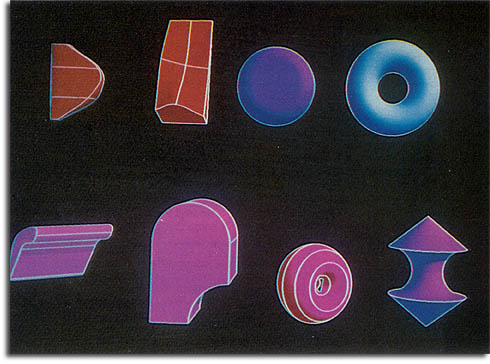 “MAGI builds their objects by assembling a library file of solid geometric shapes. Their Synthavision process has the capability to add and subtract these solids in order to create anything from lightcycles to tanks.”
“MAGI builds their objects by assembling a library file of solid geometric shapes. Their Synthavision process has the capability to add and subtract these solids in order to create anything from lightcycles to tanks.”Computing the Scene
“If I can call back to him at lunch time today and say to him that the scene is now correct, he’ll put that completed disk into the computer which will produce a high resolution color version of the scene in a few hours – that’s what we call computing the scene,” Kroyer explains. “When the scene is computed it is transferred to tape for storage, the disk is erased and used to start a new scene. The tape becomes the permanent record of the scene. Eventually that tape is fed into a machine that transfers the image onto high-resolution color movie film, VistaVision format. The resolution is expressed in lines and we are running at about 2,000 lines, which, I am told, is higher resolution than the film stock we are using. Some of our scenes contain over one million pixels (picture elements).
“When we get our film in VistaVision we view it using a VistaVision projector. The film is rear-projected so we can stand right up to the screen to examine the quality of the image … and it’s sharp.”
For you hardware buffs, here is a rundown on some of the hardware used to create the images in TRON. MAGI operates with a Perkin Elmer System 3240 computer to make the calculations for each picture it generates. The system functions with two megabytes of MOS memory and two 80-megabyte disk drives, and talks to a Celco DFR 4000 computer, which is used to generate the pictures onto a monitor.
Triple-I’s main computer is a custom-built one-of-a-kind which they call the Foonley F-1. The pictures are generated on a PFR recorder, which is manufactured by the company, and programmers use a 40-inch by 60-inch Taylos encoding tablet to plot the vector lines for the various images.
“MAGI and III have very different methods of creating scene simulations,” says Kroyer. “MAGI uses a geometric system. They build their images out of solid geometry. They make objects by combining sets of geometric objects of shapes that are put together into whatever form they want. Of course, not only can they add geometric solids, but they can subtract solids as well. As a very simple example if we wanted a wheel, we might start with a sphere and start chopping off parts of it to get down to the shape we were looking for.
“MAGI has created the lightcycles, the tanks, the Recognizers, etc. They constructed those objects by assembling a set of solid shapes. The entire object is constructed around a single center point. To animate the object, basically what we are doing is moving that center point and the constructed object moves along with it.
Triple-I’s system is completely different. They use a vector graphic method to create objects. All of the objects are built by constructing a shell out of polygons, instead of creating a solid object using solid geometries. Triple-I defines the points of a surface and they connect those points into a series of polygons. They have computer programs that smooth, shade and color the surface.
“Their method is much more suitable for complex organic shapes, because you don’t really have to rely on the existence of regular geometry. You can define points in any fashion and create any sort of shape out of polygons. That’s why they can do human faces, like the MCP [Master Control Program], or very organic-looking shapes like the Solar Sailer. Their system seems to be a bit more difficult to choreograph because they carry a much greater data base, so we tend to give III the simpler choreography, relying more on their visual beauty; MAGI tends to get the more difficult and complicated choreography, because their visuals tend to be a bit more simple. Both look beautiful and both companies do great choreography, so it’s just a matter of emphasis.”
Meet Bit
“Digital Effects in New York did an opening piece of a man forming out of energy and they also created a character called Bit. Bit is a little geometric object that flies around a bit like, well, Tinkerbell, I guess,” laughs Kroyer. “Bit changes shape to express its mood. When it’s angry or giving negative opinions, it becomes a brittle kind of pointy shape. When it’s in a pretty good mood and answering in the affirmative, he goes down to more of a soft-shaded look. Bit is Flynn’s mascot, in a way.”
It takes quite a lot of computer power to work effectively in computer graphics. Some of III’s graphics require 75,000,000 calculations to create one frame of computer animation. Multiply that by 1,240 frames needed to make one minute of film and the immensity of the task becomes apparent.
Four Hewlett-Packer 9826 computers are needed to calculate exposure control during the optical process which will give TRON‘s fantasy setting its unique “electric” look. A Cinetron 1100B is used for camera moves on cranes and motion control when required.
The “electric” look is achieved using the “candy-apple” look developed by Richard Taylor and Richard Edlund while they were working for Bob Abel’s company some years ago. (This technique was discussed in the TRON article in STARLOG #60.) Kroyer suggests that if there is ever a TRON II, this method of photo-rotoscoping and bottom lighting mattes to create the candy-apple look will be abandoned. Instead, the live-action footage will be completely digitized and manipulated within the computer itself. Once the film is digitized it can be manipulated any way the artists imagine. The live action can be colored, distorted, combined with other objects and, of course, completely without “matte lines” since there are no “mattes.” Even mohair or fur can be easily “matted.” Everything is combined inside the computer. The optical printer will be a museum relic, replaced by the digital printer.
But for the moment, TRON is pushing the technology of computer graphics along, even as the film is being made. “For example,” begins Kroyer, “in the early stages we had problem with scenes looking flat – they just didn’t look like they had any depth. We asked the people at MAGI to create for us an artificial atmosphere in the scenes that would make things appear to be dimmer or less distinct as they receded in the distance.
“They came up with a program called ‘depth-cluing’ that automatically made the pixels dim out at a geometric rate from the point that camera was supposed to be. This created the effect of an artificial atmosphere and added tremendous ‘depth’ to the scene. We came up with all sorts of little refinements that added interest and ‘reality’ to a scene: secondary light sources, different kinds of glows, diffusion programs, etc. We kept asking III and MAGI for more tools to work with and they would go back to their desks and conceive programs necessary to meet our demands which were growing more and more complicated.”
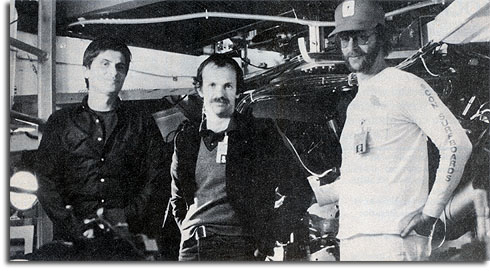 “Left to right: TRON producer Donald Kushner, associate producer & co-supervisor of SFX, Harrison Ellenshaw and co-supervisor of SFX Richard Taylor.
“Left to right: TRON producer Donald Kushner, associate producer & co-supervisor of SFX, Harrison Ellenshaw and co-supervisor of SFX Richard Taylor.All this computer excitement has been spreading around the studio. Home computer enthusiasts have even been able to work some of TRON‘s graphics on their home computers. “I think there is someone here at the studio that has a Recognizer up on his Apple II and he can move it around using the Apple software,” says Kroyer.
“Now if you are going to ask me if I think computer animation will replace classic Disney animation, the answer is, ‘No.’ Computer animation will never replace the kind of character animation that made the Disney films great. What we are dealing with here is an entirely different kind of tool, it doesn’t replace anything. Computer animation opens up whole new areas for the artist; it’s another kind of tool, a new brush. The scenes we created on computer could not have been done by any other method. It would have taken 100 animators 10 years to do what we did.”
And what a powerful tool computers are for the artist. Richard Taylor of Triple-I sums it up with: “For objects simulated in a computer, there are no laws of physics. Each time you sit down to create a computer image, you are getting completely new rules for reality. That’s what TRON is all about.”
I think my favorite element of the article is the discussion of how the production pipeline will probably be much easier if they were to make a TRON II. They were right, of course, but I doubt that they were planning it for 2010. The points about digital compositing were well taken, as those techniques have indeed made optical printers obsolete.
So when you’re in the theater watching the new film, think about back in the day when the two animators on a film had to call New York to describe their scenes, and wait for the pencil tests to appear via a telephone link.
As to the crew from the article, they all went on to a variety of projects. Kroyer, despite his predictions, segued into a career in computer animation, although he did return to the hand-drawn world to direct Ferngully in 1993. He went on to a career in visual effects at Rhythm and Hues. Jerry Rees, the other animator on TRON, went on to direct the maddeningly under-rated The Brave Little Toaster in 1987. Aside from a number of non-Disney projects, he directed a number of theme park films and projects including the famous Back to Neverland with Walter Cronkite and Robin Williams, the live-action scenes for Cranium Command, and Cinemagique at Walt Disney Studios Paris.
MAGI went on to do the animation for John Lasseter’s demo of his proposed Where The Wild Things Are project at Disney in 1983; the company was bought out by another corporation a few years later. Triple-I got out of the movie business soon after TRON, but continued to develop technology in other fields until it merged with another company in 1996.
And here, as a final retro snapshot for the day, is an ad for TRON‘s soundtrack from the same issue of STARLOG. Includes a new Journey song!
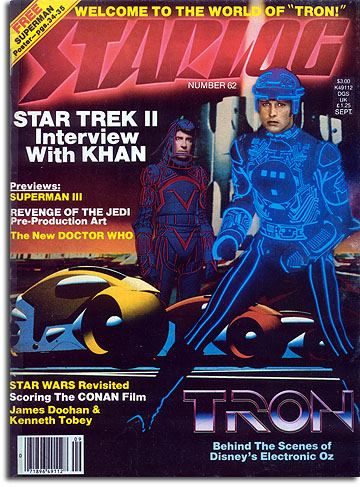
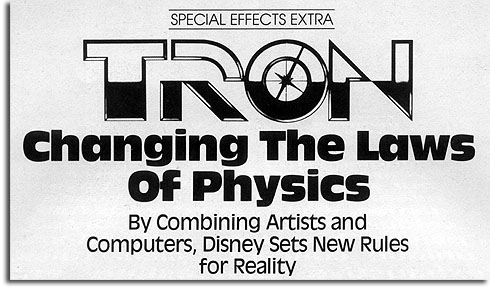
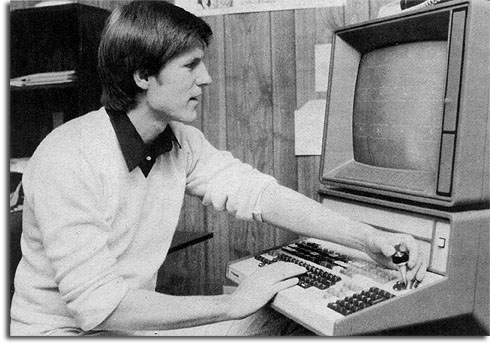
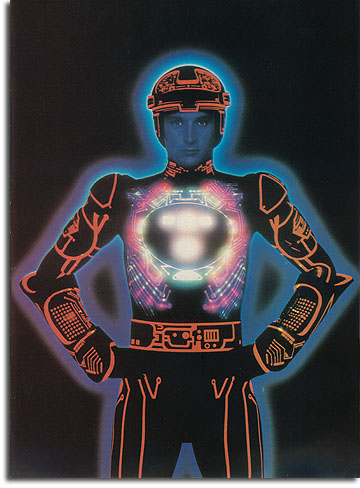
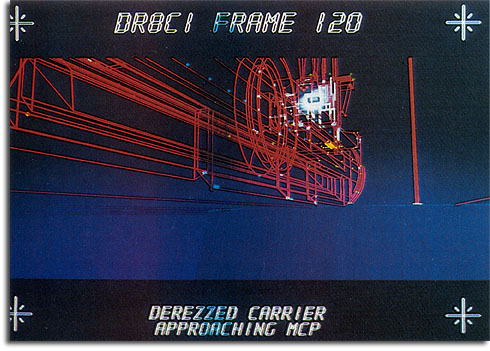
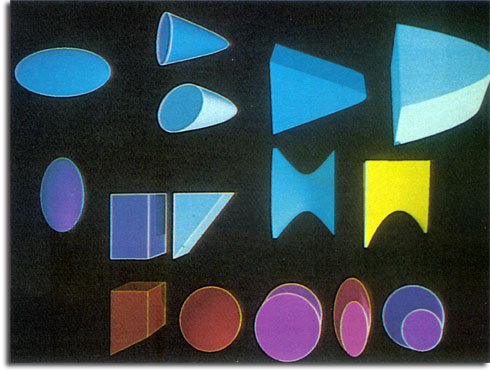

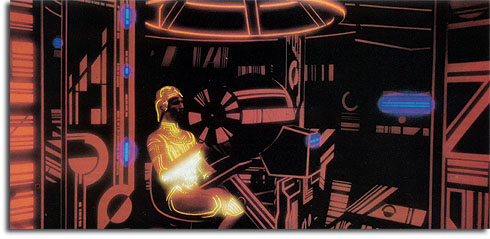
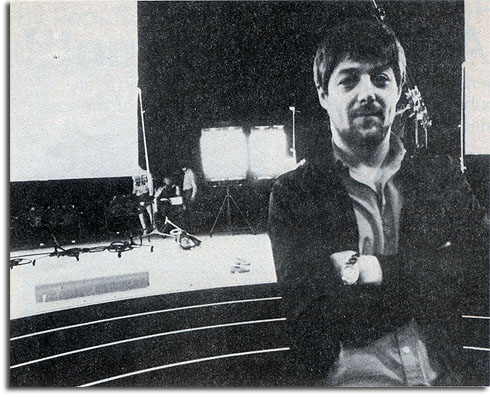









Recent Comments